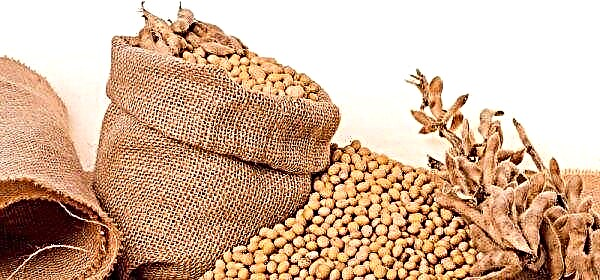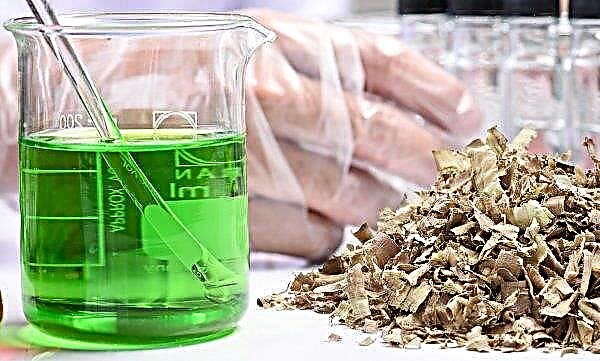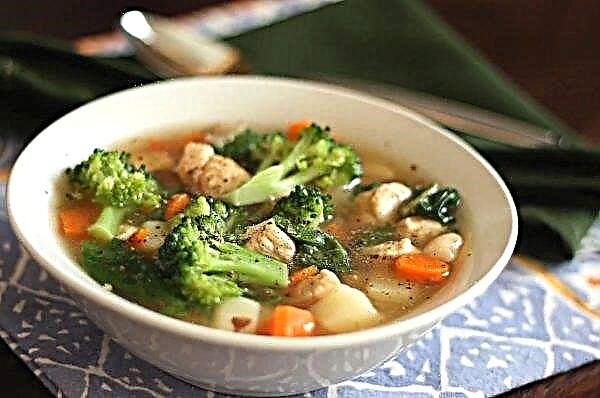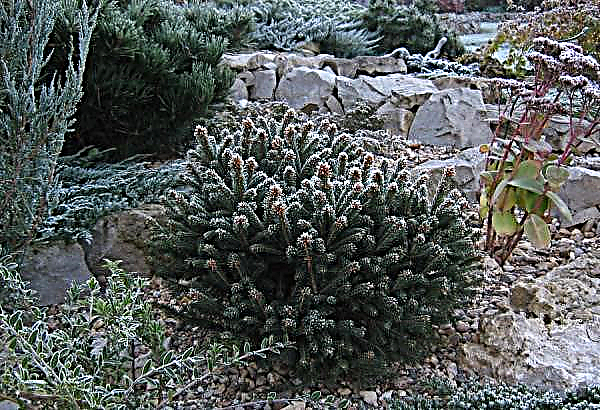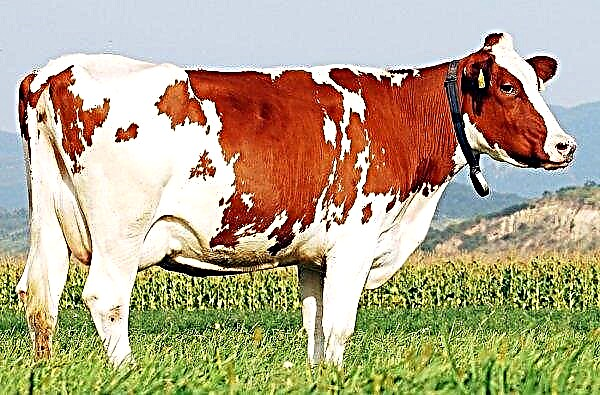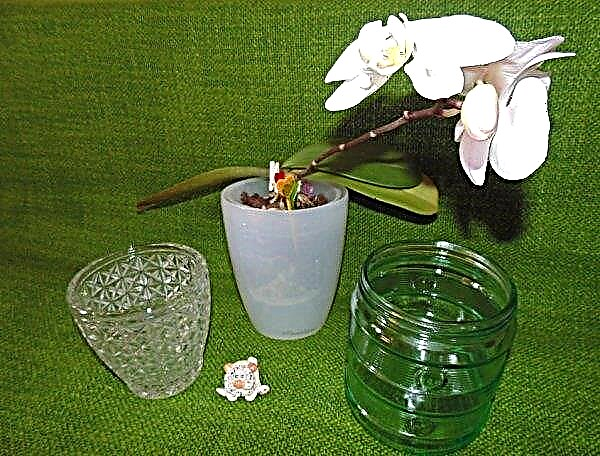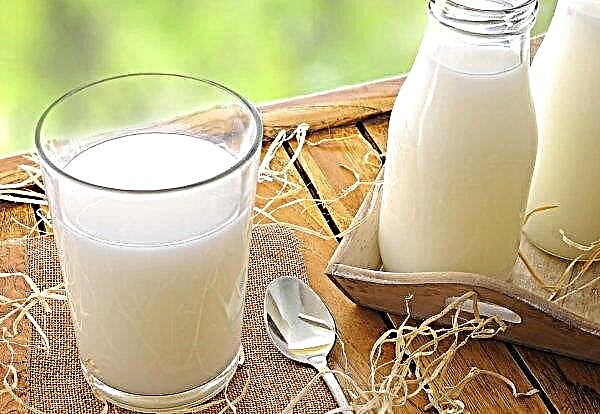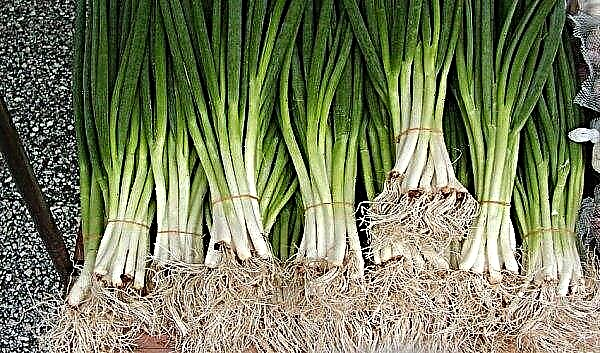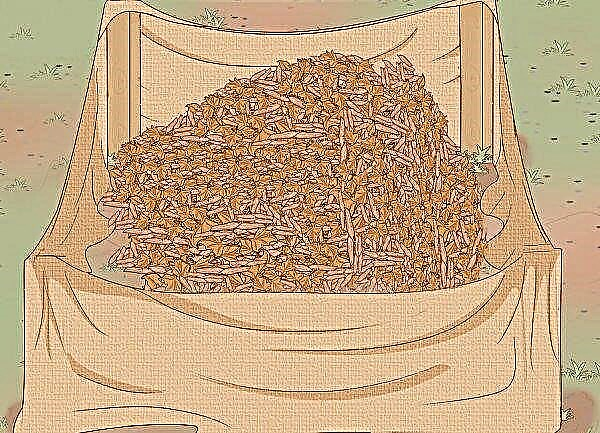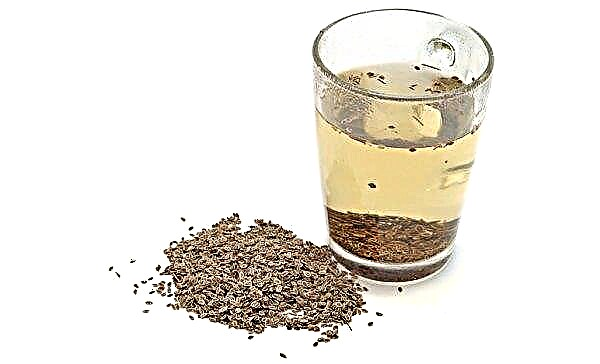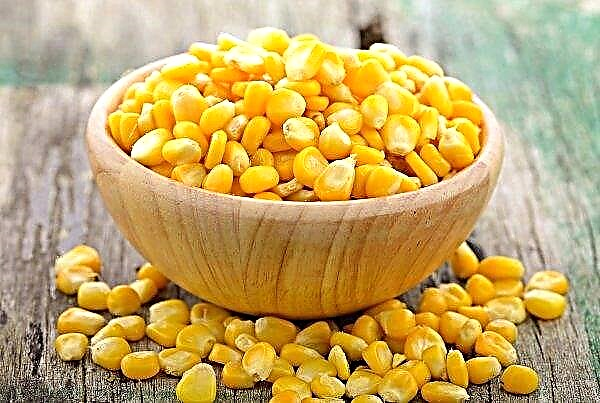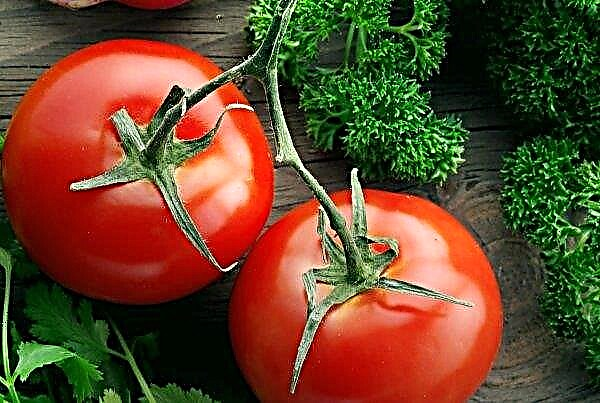Pumpkin is grown on all continents except Antarctica. This culture has been cultivated for more than 5 thousand years and came to us from Mexico. There are about 20 types of pumpkins in the world, and among them the Butternat variety, which has pulp with an unusual nutty flavor, occupies a worthy place. We offer to learn more about this vegetable: its features, growing conditions and care.
Did you know? Pumpkins are not only orange and yellow, but also blue, white, green.
Grade description
Butternat - a pumpkin variety obtained by crossing wild African pumpkins and nutmegs, although bred in distant America, has been popular with us for many years. This squash is also called squash - for its pear-shaped shape, and due to its unusual flavor - nutty or nutmeg. The variety is universal in use.
Characteristic:
| Fruit size | 1–1.2 kg |
| Fruit shape | Pear-shaped |
| Leaf shape | Lobed |
| Pulp color | Bright orange |
| Flowers | Large yellow |
| Seeds | Large white |
| Peel | Thick Orange |
| Peduncle | Thick, covered with spiky hairs |
| Root | Up to 3 m |
| Calorie content | 45 kcal per 100 g |

Advantages and disadvantages
- Pumpkin butternut has a number of advantages and useful properties:
- stored for a long time at home - up to 1 year;
- short ripening period - 3 months .;
- few seeds and a lot of pulp;
- contains many vitamins and minerals: C, B9, E, K, calcium, potassium, phosphorus, magnesium;
- low calorie;
- compact
- cleanses the intestines, relieves constipation;
- improves eyesight;
- strengthens the immune system;
- removes toxins from the body;
- strengthens the walls of blood vessels.
- The disadvantages include the fact that the vegetable:
- afraid of frost;
- needs watering.
Planting and growing
Since the variety is obtained from crossing tropical varieties, the specificity of its cultivation differs from caring for vegetables of this family.
The necessary conditions
The variety is heat-loving, so when planting, you must choose a place on the south or southeast side of the site. Nutritious soil is needed - it has been fertilized since the fall. Suitable rotted manure or green manure.  In the northern regions with cold nights, you can’t get a good harvest. At the stage of growth and formation of fruits, pumpkin needs a sufficient amount of moisture. In the absence of precipitation it will have to be watered.
In the northern regions with cold nights, you can’t get a good harvest. At the stage of growth and formation of fruits, pumpkin needs a sufficient amount of moisture. In the absence of precipitation it will have to be watered.
Soil and crop rotation requirements
Pumpkin needs a light but nutritious land with neutral acidity. Since the roots of the pumpkin are long and branched, they take maximum nutrients from the soil. Therefore, every year the landing site needs to be changed, otherwise the land will be depleted.
It is not recommended to plant a vegetable where tomatoes, carrots and late cabbage previously grew. It is better to use the beds after growing onions, garlic, and legumes.
Sowing seeds for seedlings
Before you start laying the seeds in the ground, you need to prepare them.
For this:
- Water is poured into a suitable container.
- Pumpkin seeds are dipped in water.
- Throw out those that have surfaced.
- The selected material is soaked in a weak solution of potassium permanganate (1%) for 30 minutes.
- It is wrapped in a damp cloth and sent to the refrigerator for hardening for a day.
While the seeds are hardened, you can tackle the soil. If this is purchased soil, then it does not require additional processing. To prepare the soil from the garden earth, you need to take 1 part of chernozem, peat and sand.  You can add a little rotted compost. This mixture must be decontaminated. To do this, just pour boiling water over it and leave to dry.
You can add a little rotted compost. This mixture must be decontaminated. To do this, just pour boiling water over it and leave to dry.
Sowing is carried out in this way:
- Separate containers are filled with the finished soil mixture.
- Ready seeds are put in them.
- Top seeds sprinkled with earth at 4-6 cm.
- The soil is moistened from a spray.
- Crops are covered with glass or film.
Seedling Care
After sowing, covered containers are placed in a warm place. A window facing the south side will do. The temperature should be +23 ... + 25 ° С. When the sprouts hatch, the shelter is removed, and the temperature is lowered so that the plants do not quickly stretch out in growth. They also monitor the moisture of the soil, preventing it from drying out. Watering is carried out with room water under the root.
Did you know? In terms of botany, pumpkin — berry, albeit a big one. The largest pumpkin in the world weighed 250 kg.
Planting seedlings in the ground
Young plants are planted when they reach 15–20 cm in length. By this time, air and earth will finally warm up. Usually this is the end of May - the beginning of June. The site must be prepared in advance: dug up with fertilizer, all weeds removed. If the pumpkin was grown in peat glasses, then their walls are destroyed and the seedlings are carefully lowered into a pre-watered hole.
Plants are planted according to the 1 × 1 meter scheme, since they need a lot of space for branching. Landing is carried out in the evening or in cloudy weather. The first days of the plant are watered every day in the evening, under the root.
Care Features
Butternat care is simple and includes the activities that any garden crop requires: watering, weeding weeds, loosening the soil.
Important! Pumpkin seeds are one of the best sources of zinc, which is useful for maintaining men's health. Also, pumpkin seeds have an anthelmintic effect.
Watering and feeding
From the moment of planting and until the fruit stains, the pumpkin is abundantly watered 3-4 times a month, under the root. Three weeks before the ripening, when the fruits have already grown and stained, watering is stopped so that the vegetable gains sugar content and is not too watery.
If the soil on the site is nutritious and well fertilized since the fall, then you can do without dressing. But on light sandy soil, pumpkin will quickly pick up nutrients and have to feed it. This can be done after 2 weeks from the moment of planting and with an interval of 14 days - no more than 3 times per season. When the fruit is already ripening, top dressing is not introduced. It is better to use organics - mullein, nettle infusion, chicken droppings. Top dressing is applied only after watering and not more than 1 liter under the bush.
Important! Although pumpkin has a lot of useful properties, it is not recommended to use it with increased acidity of the stomach and diabetes.
Loosening the soil and weeding the beds
While the pumpkins have not yet begun to shoot lateral shoots and spread along the ground, it is necessary to regularly loosen the ground and remove weeds. When the plantings grow, it is better not to disturb them, since the stems break easily. Weeding is combined with watering.

The next day after watering, the soil is loosened, because after moistening, a crust forms, which prevents oxygen from freely flowing to the roots.
Bush formation
If you look at the garden with a pumpkin, it seems that it grows by itself. But to get a plentiful harvest, there is a trick - pinching the top shoot. This gives an impetus to the development of lateral shoots, on which more “female” flowers are formed. It is from them that the fruits are tied.
So that the pumpkin does not grow into neighboring plantings, the lashes are sent in the right direction. Also, to obtain larger fruits, one vegetable is left on each lash, the rest are removed.Growing difficulties
Butternate is not susceptible to disease. However, if the weather or soil is not suitable for her, she begins to hurt.
Common Diseases:
- Powdery Mildew Signs: leaves turn white, then dry and curl. For treatment, 1% solution of copper sulfate is used.

- Bacteriosis. Signs: leaves and fruits are covered with brown and brown spots. The disease can be recognized even before sowing the seeds. Brown spots will be visible on infected people. Only high-quality material is selected for sowing. It is also necessary to carefully remove all residues of plants and fruits from the site so that they do not infect the soil.

- White rot. Signs: whitish spots appear on the plant tissues, which eventually decay, turn black. The fungus affects all parts of the plant. Plants can be saved by cutting the affected areas with a knife and sprinkling with wood ash. Do it in dry weather.
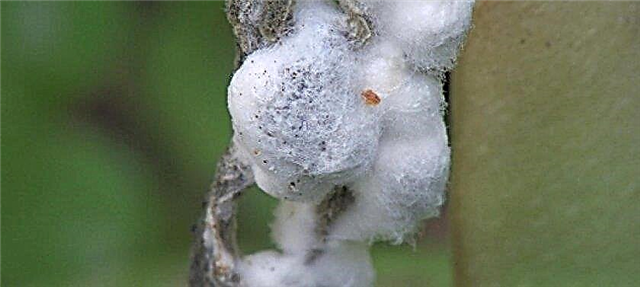
- Root rot. It occurs with a sharp temperature difference and watering with cold water. Signs: the leaves turn yellow and the plant dies. When there are signs of the disease, soil is sprinkled on the shoots lying on the ground - for the formation of new roots.

Of the pests for Batternat, a spider mite and a melon aphid are dangerous. These pests are activated in dry weather. Therefore, to prevent adversity, you can prepare an infusion of onion and garlic husks. To prepare it, take 200 g of husk and pour 10 liters of boiling water. Insist 4 hours, filter and spray the plant.
Harvest Dates
Butternate is harvested in September, before the rainy season. Matured pumpkins have a beautiful orange color.
You can store the crop in a dry cellar, but better at room temperature. In the apartment you can hide the fruits under the bed. In a private house - in a warm attic or porch. If the room is dry, the pumpkin is stored until the next harvest. If there are immature specimens, they are put in a dark place - they will ripen.
Cooking Tips
From this beautiful and healthy vegetable you can prepare many dishes. The classic is pumpkin porridge. They also make casseroles, pies, stews, soups, desserts. It is steamed, stewed, boiled, fried. The maximum amount of vitamins is preserved if steamed vegetables with a tightly closed lid. It is convenient to do this in a slow cooker.
Butternat is a popular, albeit demanding, variety. But, having planted this pumpkin in your home once, you will love it forever. With proper care, the vegetable will delight you with a good harvest, and the source of natural vitamins will be on your table all fall and winter.





